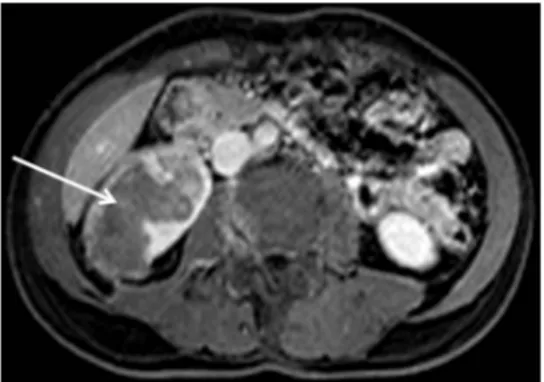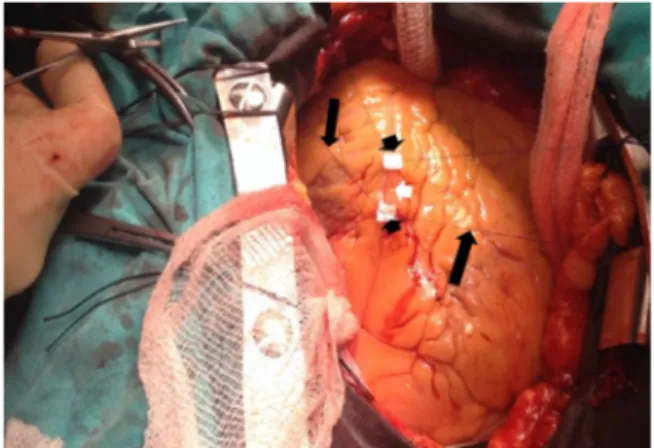CASE REPORT
Staged off-pump coronary artery bypass grafting
and radical nephrectomy in a patient with
multivessel coronary artery disease and a renal
tumour
Erdem Cetin,
1Arda Ozyuksel,
2Ferruh Akay
31Department of Cardiovascular Surgery, Memorial Hospital, Diyarbakır, Turkey
2Department of Cardiovascular Surgery, Medipol University, Istanbul, Turkey
3Department of Urology, Memorial Hospital, Diyarbakır, Turkey Correspondence to Dr Arda Ozyuksel, ozyukselarda@yahoo.com Accepted 6 June 2014 To cite: Cetin E, Ozyuksel A, Akay F. BMJ Case Rep Published online: [ please include Day Month Year] doi:10.1136/bcr-2013-202481
SUMMARY
Coronary artery diseases and neoplastic disorders are the leading causes of morbidity and mortality in the elderly. Recently, controversial approaches have been raised about the treatment of cases with concomitant occurrence of coronary artery diseases and malignancies. The detrimental effects of cardiopulmonary bypass on neoplastic cells are always a challenge for such cases. We present a case of a large renal tumour associated with a recently symptomatic coronary artery disease which was successfully treated with staged off-pump coronary artery bypass grafting followed by radical nephrectomy. In such patients, off-pump
revascularisation is favourable in order to decrease the risk of cancer spreading when compared to traditional on-pump cases. In our opinion, staged off-pump
coronary arterial revascularisation followed by definitive
surgical treatment for the malignancy is a safe and effective treatment modality in patients with coronary artery disease and oncological diseases.
BACKGROUND
Cardiovascular and oncological diseases are the leading causes of death among the elderly popula-tion.1 In the last decade, controversial approaches have raised about the treatment of cases with con-comitant occurrence of these two entities. Thefirst discussion was focused on the risks of simultaneous surgical treatments of critical coronary artery disease (CAD) and the neoplastic disorder.2 Afterwards, detrimental effects of cardiopulmonary bypass (CPB) on neoplastic cells drove attention, which may lead to uncontrolled local and systemic spread of the malignant cells, even leading to the growth of hidden malignancies.3 Surgical manage-ment of coronary artery disease associated with malignancy can be successfully performed with a patient based algorithm. In this case, we present a large renal tumour associated with recently symp-tomatic coronary artery disease which was success-fully treated with staged off-pump coronary artery bypass grafting (OPCAB) for multivessel disease followed by radical nephrectomy.
CASE PRESENTATION
A 59-year-old man was admitted to the hospital with haematuria and right-sided flank pain. His medical history was unremarkable, but he was an ex-smoker (20 packs/year). On physical
examination a right-sided bluntflank mass was pal-pated. Diagnostic workup revealed a 10×12 cm right-sided renal tumour (figure 1). Preoperative workup included screening for distant metastasis which was found to be negative. The patient was scheduled for a right radical nephrectomy but meanwhile, he experienced a sudden onset chest pain spreading to his left arm. ECG showed a recent inferior myocardial infarction. Coronary angiography was performed which revealed the multivessel coronary artery disease at left anterior descending (LAD) artery, diagonal and right coron-ary arteries with an acute occlusion of circumflex artery (figure 2). Echocardiography revealed an ejection fraction of 45–50% with mild mitral regur-gitation. Primary percutaneous coronary interven-tion was performed for the acutely occluded circumflex artery and antegrade flow was provided without stenting. Afterwards, elective coronary artery bypass grafting (CABG) was scheduled and surgery for renal tumour was cancelled. Following general anaesthesia, sternotomy was performed. Pericardium and bilateral pleura were widely opened and multiple stay sutures were placed. Left internal thoracic artery and vena saphena magna were harvested. Following systemic heparin admin-istration, an activated clotting time of 300 s was achieved. Two stay sutures (6/0 polypropylene) with pledgets on the upper side of the target coron-ary arteries were placed to stabilise the proximal and distal parts of the anastomosis region for each bypass (figure 3). Haemodynamic stability was maintained withfluid administration and trendelen-burg position. CABG for the target vessels was suc-cessfully performed on beating heart without the
Figure 1 Large renal tumour at the MRI of the right kidney (arrow).
Cetin E, et al. BMJ Case Rep 2014. doi:10.1136/bcr-2013-202481 1
usage of a mechanical cardiac stabilisation device (LAD, diag-onal, optus marginalis branches and right coronary artery). Any haemodynamic instability was not encountered as well as any ischaemic changes in ECG. The sternum was approximated with 12 interrupted steel wires in order to maintain effective stability during the positioning for the subsequent nephrectomy. The perioperative period was uneventful; the patient was extubated at the third hour after operation and he was discharged at the fourth day of surgery on aspirin therapy. Two weeks after the operation, oral antiplatelet drug was ceased and subcutaneous low-molecular-weight heparin was started. At the third post-operative week, the patient was operated for the right renal tumour and radical nephrectomy was performed. The tumour arising from middle pole of the kidney was 10×10 cm. The pathological examination of the specimen confirmed papillary renal cell carcinoma at a pathological stage of T3a according to National Comprehensive Cancer Network classification. The antiplatelet treatment was initiated at the second postoperative day. Any coronary adverse event or sternal instability was not encountered in the postoperative period.
OUTCOME AND FOLLOW-UP
The patient was discharged without any complication and he is free of symptoms or recurrence of the tumour at the sixth month follow-up.
DISCUSSION
Treatment strategy for the concomitant CAD and malignancy depends on multiple factors. Patients with acute coronary syn-drome, unstable angina pectoris or acute myocardial infarction should undergo myocardial revascularisation before their surgi-cal treatment for neoplastic diseases is scheduled.4On the other hand, stable coronary artery disease can be managed medically, which does not preclude the definitive treatment of the neoplas-tic disease.4
The nature of the malignant disease also has effect on decision-making. When solid organ malignancies are considered like the renal carcinoma in our case, the preoperative evaluation and imaging workup becomes important. A large mass with local invasion will probably necessitate a more radical resection and postoperative adjuvant chemotherapy and/or radiotherapy, which definitely obligates an unobstructed coronary arterial cir-culation. In such cases, OPCAB is undoubtedly favourable in order to decrease the risk of cancer spreading when compared to CPB usage.
In patients whom a surgical treatment is planned for the con-comitantly present CAD and malignancy, OPCAB must be the choice of coronary revascularisation whenever possible. Trendelenburg position and intravenousfluid administration are the two basic precautions to provide the haemodynamic stability during the OPCAB procedure. We keep the serum potassium levels above 4.5 mEq/L in the preoperative period in order to decrease the risk of arrhythmia.
In our opinion, staged coronary arterial revascularisation with OPCAB followed by definitive surgical treatment for the malig-nancy is a safe and effective treatment modality in patients with CAD and oncological diseases. The preceding off-pump coronary revascularisation provides a safe treatment opportunity for malig-nancy including the surgery, chemotherapy and/or radiotherapy.
Patient’s perspective
The patient quickly recovered from off-pump coronary artery bypass surgery followed by a safe and successful complete
resection of the tumour without any significant delay in the
treatment of the malignancy.
Learning points
▸ Cardiovascular diseases are frequent in oncology patients when the age range is taken into account.
▸ Management of coronary artery stenosis may require surgical intervention in these patients.
▸ Staged approach can safely be performed which provides with safer treatment circumstances in terms of oncological surgery, chemotherapy and/or radiotherapy.
▸ Off-pump revascularisation must be the choice whenever possible when the detrimental effects of cardiopulmonary bypass on cancer are considered.
Contributors EC: Design, formation and critical review of the manuscript. AO: Design, formation and critical review of the manuscript. FA: Literature search and critical review of the article.
Competing interests None. Figure 2 Multiple stenotic lesions
(arrows) at the coronary angiography views of left anterior descending (left) artery, circumflex (middle) and right coronary arteries (right).
Figure 3 Operative view of the off-pump coronary artery bypass grafting with stay sutures (black arrows) and pledgets (black arrow heads) providing a bloodless and stable zone for the anastomosis of the target vessel (white arrow head).
2 Cetin E, et al. BMJ Case Rep 2014. doi:10.1136/bcr-2013-202481
Patient consent Obtained.
Provenance and peer review Not commissioned; externally peer reviewed.
REFERENCES
1 Zielinski J, Jaworski R, Pawlaczyk R, et al. Simultaneous surgery for critical aortic stenosis and gastric cancer: a case report. World J Gastroenterol 2010;16:1161–4.
2 Litmathe J, Atmaca N, Menghesha D, et al. Combined procedures using the extracorporeal circulation and urologic tumour operation—experiences in six cases. Interact Cardiovasc Thorac Surg 2004;3:132–5.
3 Darwazah AK, Shehata S. Detrimental effect of cardiopulmonary bypass (CPB) on malignant disease. J Cardiothorac Surg 2011;6:13.
4 Darwazah AK. Surgical management of coronary artery disease associated with malignancy. J Card Surg 2012;27:581–8.
Copyright 2014 BMJ Publishing Group. All rights reserved. For permission to reuse any of this content visit http://group.bmj.com/group/rights-licensing/permissions.
BMJ Case Report Fellows may re-use this article for personal use and teaching without any further permission. Become a Fellow of BMJ Case Reports today and you can:
▸ Submit as many cases as you like
▸ Enjoy fast sympathetic peer review and rapid publication of accepted articles ▸ Access all the published articles
▸ Re-use any of the published material for personal use and teaching without further permission For information on Institutional Fellowships contact consortiasales@bmjgroup.com
Visit casereports.bmj.com for more articles like this and to become a Fellow
Cetin E, et al. BMJ Case Rep 2014. doi:10.1136/bcr-2013-202481 3
Unusual association of diseases/symptoms
View publication stats View publication stats

